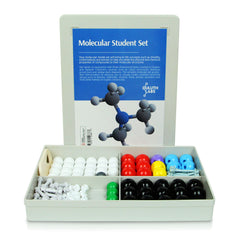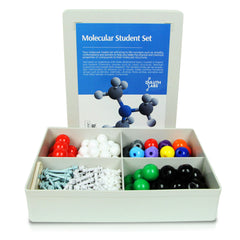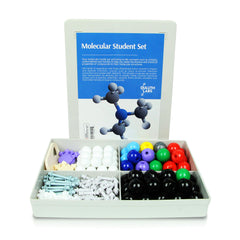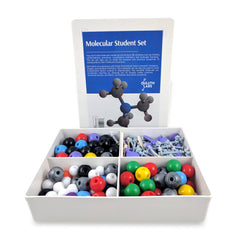Testosterone: A body builder’s booster
Testosterone is a vital molecule that is greatly responsible for the development of male sex attributes. Female also have testosterone in smaller amounts. Testosterone levels start to peak during puberty stage. During this stage, a male starts to experience different changes in terms of their physical appearance (growth of facial hairs, and acne), lowering of the voice changes in body built, and behavioral changes. These occurrences during the puberty stage are all brought about by the increased levels of testosterone in the body.
What does Testosterone look like in Chemistry?


Let’s Get Building!
Using your Student Molecular Model Set from Duluth Labs let’s create Testosterone! You’ll need:
-
19 Carbon Atoms
-
2 Oxygen Atoms
-
28 Hydrogen Atoms
-
28 Small connectors (compact small bonds for hydrogen)
-
22 Medium connectors
-
4 Long connectors
Note: To complete the modelling successfully (sufficient number of atoms) you may need either our Duluth Labs MM-004 Set OR Duluth Labs MM-006 Set.
Put aside all the atoms and connectors needed.

Let’s Start Building With Our Ring A Portion!
Note: We begin with building Ring A of testosterone molecule, starting at Carbon 1. We build this portion of the molecule in a counterclockwise direction.

Let’s start!
Steps:
-
1

1. Get one carbon atom (Carbon 1) then attach one carbon (Carbon 2) on its left using a medium connector.Then, add 2 hydrogen atoms to both Carbon 1 and Carbon 2 using 4 short connectors.
-
2

2. Attach another carbon (Carbon 3) atom below Carbon 2 using a medium connector.
-
3

3. Then, get an oxygen atom and attach this to Carbon 3 using 2 long connectors.
-
4

4. Get another carbon atom (Carbon 4)then attach this to carbon 3 using 1 medium connector. Add one hydrogen atom to carbon 4 using 1 small connector.
-
5

5. Attach one carbon (Carbon 5) atom to Carbon 4 using 2 long connectors. Get another carbon (Carbon 10) then attach this above Carbon 5 using 1 medium connector.
-
6

6. Have another Carbon atom (Carbon 19) attached above Carbon 10 using a medium connector. Place 3 hydrogen atoms on Carbon 19 using 3 short connectors.
-
7

7. Connect Carbon 1 and Carbon 10 together using a medium connector.
-

Yay! We've just built our Ring A Portion!
Note: We now proceed with building Ring B of the testosterone molecule, starting with Carbon 9. We build this portion of our molecule in a clockwise direction.

Let’s continue building!
Steps:
-
1

1. Attach one carbon atom (Carbon 9)to Carbon 10 using a medium connector. Place one hydrogen atom on Carbon 9 using a small connector.
-
2

2. Get another Carbon atom (Carbon 8) then attach this to Carbon 9 using a medium connector. Then, add a hydrogen atom to Carbon 8 using a small connector.
-
3

3. Attach another carbon (Carbon 7) atom below Carbon 8 using a medium connector. Then, place two hydrogen atoms on carbon 7 using 2 small connectors.
-
4

4. Get another carbon atom (Carbon 6) and attach this to Carbon 7 using a medium connector. Place 2 hydrogen atoms on Carbon 6 using 2 small connectors.
-
5

5. Join Carbon 6 and Carbon 5 together using a medium connector.
-

Hooray! We've just built our Ring BPortion!
Note: We now proceed with building Ring C of the testosterone molecule, starting with Carbon 11. Likewise, we proceed with building this portion in a clockwise direction.

Let’s continue building!
Steps:
-
1

1. Attach one carbon atom (Carbon 11) above Carbon 9 using a medium connector. Then, add 2 hydrogen atoms to Carbon 11 using 2 small connectors.
-
2

2. Connect another carbon atom (Carbon 12) to Carbon 11using a medium connector. Likewise, add 2 hydrogen atoms to Carbon 12 using 2 small connectors.
-
3

3. Add another Carbon (Carbon 13) then attach this to Carbon 12 using a medium connector.
-
4

4. Get another carbon atom (Carbon 18) then attach this above Carbon 13 using 1 medium connector. Add 3 hydrogen atoms to Carbon 18 using 3 small connectors.
-
5

5. Get another carbon atom (Carbon 14)then have this attached to Carbon 13 using 1 medium connector. Then, add a hydrogen atom below Carbon 14 using a small connector.
-
6

6. Join Carbon 14 and Carbon 8 together using a medium connector.
-

Hooray! We've just built our Ring C Portion! We’re close to building our Testosterone molecule
Note: We now proceed with building Ring D of the testosterone molecule, starting with Carbon 17.

Let’s continue building!
Steps:
-
1

1. Get one carbon atom (Carbon 17)then attach this to Carbon 13 using one medium connector. Add 1 hydrogen atom to Carbon 17 using a small connector.
-
2

2. Then, get one oxygen atom then attach this to Carbon 17using one medium connector. Add a hydrogen atom to this oxygen using a small connector.
-
3

3. Get another carbon atom (Carbon 16)then attach this to Carbon 17 using a medium connector. Likewise, add 2 hydrogen atoms to Carbon 16 using two small connectors.
-
4

4. Attach one carbon atom (Carbon 15) below Carbon 16 using a medium connector. Place 2 hydrogen atoms to Carbon 15 using 2 small connectors.
-

5. Join Carbon 15 and Carbon 14 together using 1 medium connector.
Great work! Now we have our newly-built Testosterone molecule.
Feel free to show us how your Testosterone turned out!
Comment and share pictures below! Tune in next week for another molecule of the week! See you then xoxo :)





























